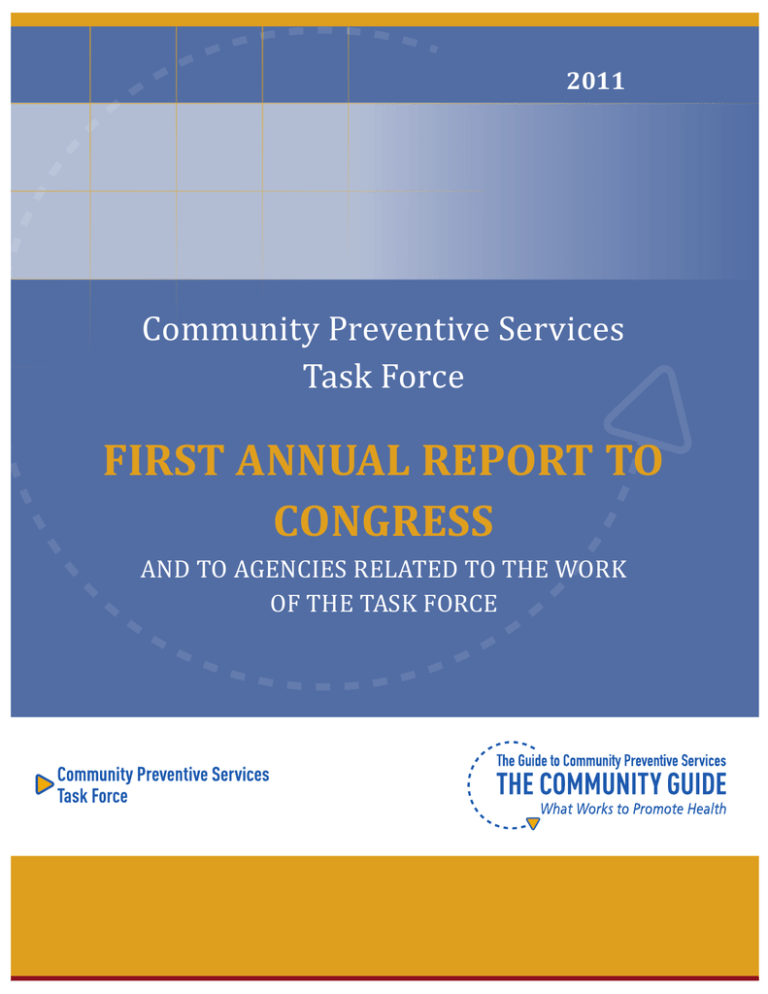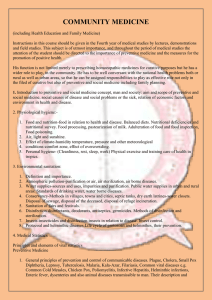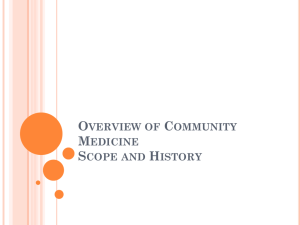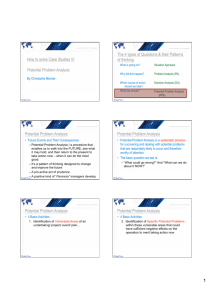FIRST ANNUAL REPORT TO CONGRESS Community Preventive Services Task Force
advertisement

2011 Community Preventive Services Task Force FIRST ANNUAL REPORT TO CONGRESS AND TO AGENCIES RELATED TO THE WORK OF THE TASK FORCE The Patient Protection and Affordable Care Act (ACA), § 4003(b)(1) amends the Public Health Service (PHS) Act to add Section 399U Community Preventive Services Task Force, which authorizes the provision of an independent Community Preventive Services Task Force convened by the Director of the Centers for Disease Control and Prevention. It also describes duties of the Community Preventive Services Task Force (heretofore known as the Task Force on Community Preventive Services, and referred to hereafter as the Community Preventive Services Task Force or “Task Force”), which include: “…providing yearly reports to Congress and related agencies identifying gaps in research and recommending priority areas that deserve further examination, including areas related to populations and age groups not adequately addressed by current recommendations.” (ACA, § 4003(b)(1); PHS Act § 399U(b)(6)) (ACA pages 425-426) The 2011 annual report was prepared by the Task Force in response to this legislation. The Centers for Disease Control and Prevention provides “ongoing administrative, research, and technical support for the operations of the Task Force.” (ACA, § 4003(b)(1); PHS Act § 399U(c)) (ACA page 426) Executive Summary INTRODUCTION Decision makers in communities, companies, health departments, health plans and healthcare systems, non-governmental organizations, and at all levels of government can better protect and improve the public’s health by knowing what works. For this, they can rely on recommendations by the Community Preventive Services Task Force (Task Force), compiled in The Guide to Community Preventive Services (Community Guide; www.thecommunityguide.org). These recommendations identify programs, services, and policies proven effective in a variety of realworld settings—such as communities, worksites, schools, and health plans. Task Force recommendations empower community, local, state, federal, tribal, territorial, corporate, public health, and healthcare decision makers to optimize resources to: Protect and improve health; Reduce demand for future healthcare spending that is driven by preventable disease and disability; and Increase productivity and competitiveness of the U.S. workforce. This report—the Task Force’s first Annual Report to Congress—provides background on the Task Force, its methods, findings, and recommendations, and describes both gaps in existing research on community preventive services and priorities for future Task Force efforts. BACKGROUND The Task Force is an independent, nonfederal, "The Community Guide is a foundational volunteer body, appointed by the Director of the resource for our health strategy at Dow. Centers for Disease Control and Prevention (CDC), It is a critical, valuable, go-to source for whose members represent a broad range of evidence-based strategies, policies and research, practice, and policy expertise in programs for population health." community preventive services, public health, health Catherine M. Baase, MD promotion, and disease prevention. The Task Force Chief Health Officer, was established in 1996 by the U.S. Department of The Dow Chemical Company Health and Human Services to provide evidencebased recommendations about community preventive services, programs, and policies that are effective in saving lives, increasing longevity, and improving Americans’ quality of life. Policy makers, practitioners, and other decision makers use Task Force findings and recommendations to help them make informed decisions about allocating scarce resources to effective programs, services, and policies across a broad range of health priority areas. CDC is mandated to provide the Task Force with ongoing administrative, research, and technical support for all of its operations. The Task Force bases its recommendations on a rigorous, replicable “systematic review” process that: Evaluates the strength and limitations of existing research evidence for community-based health promotion and disease prevention programs, services, and policies in high-priority topic areas; Assesses whether the programs, services, and policies are effective in promoting health and preventing disease, injury, and disability; Examines the applicability of these programs, services, and policies to varied populations and settings; and Conducts appropriate economic and financial analyses of cost and return on investment, to provide a full complement of information to inform decision-making. These systematic reviews are conducted, with oversight from the Task Force, by scientists and other subject matter experts from CDC in collaboration with a wide range of government (federal, state, and local), academic, policy, and practice-based partners and stakeholders. The Task Force examines the evidence, produces findings and recommendations about effective and ineffective programs, services, and policies, and identifies research gaps that need to be filled. In all aspects of its work, the Task Force obtains input from partner organizations and agencies, and from individual policy makers, practitioners, and researchers. Many of the nation’s leading health practice and research agencies and organizations hold official Liaison status with the Task Force. They participate in meetings of the Task Force; serve on systematic review teams; represent the views, concerns, and needs of their “Before we had the Community organizations and constituents; and disseminate Guide recommendations, we lacked findings to their members and constituents. Task Force reviews, findings, and recommendations are compiled in the Guide to Community Preventive Services (Community Guide). The Community Guide (www.thecommunityguide.org) provides a range of information that can inform multiple decision makers and stakeholders about effective allocation of scarce resources to proven programs, services, and policies. The Task Force’s evidence-based findings and recommendations (218 to date) address high-priority topics including those related to the nation’s leading causes of preventable morbidity and mortality, which affect Americans of all ages and all population subgroups. Topics of Task Force reviews and recommendations include: chronic diseases, such asthma, cancer, depression, diabetes, and heart disease; infectious diseases; behavioral health risks related to diet, physical activity, and alcohol and scientifically based guidance for developing sound and effective policies and interventions for the problems we collectively face (as state public health officers). This lack of evidence made our jobs that much more difficult, especially since elected public officials have increasingly asked us to do more with fewer resources, and hold us accountable for cost-effective results. This is where the Community Preventive Services Task Force plays such a vital role.” Martin P. Wasserman, MD, JD Former Secretary of the Maryland Department of Health & Mental Hygiene, and Former State Health Officer and Administrator, Oregon Health Division, Department of Human Services tobacco use; workplace health promotion; and public health and healthcare systems and supports required to deliver evidence-based preventive services. CURRENT RESEARCH GAPS The Task Force has identified, and discusses in detail in the full report, three types of research gaps. These gaps limit the Task Force’s ability to provide decision makers with the full complement of information they need to combat their most pressing public health concerns. 1. Research gaps where there is insufficient evidence to determine whether or not programs, services, and policies are effective in any populations, settings, and circumstances. 2. Research gaps where there is insufficient evidence to know whether programs, services, and policies found to be effective in some populations, settings, and contexts would be effective in others. 3. Research gaps related to information that is needed to adequately support practitioners, policy makers, and other decision makers in selecting and implementing effective community-based programs, services, and policies that meet their needs, preferences, constraints, and available resources. PRIORITIES FOR FUTURE TASK FORCE REVIEW TOPICS Future Task Force review topics are identified and prioritized through a multi-stage process that includes extensive input from partners, stakeholders, and the general public. Currently, the highest-priority topics for future Task Force reviews include: Cardiovascular disease prevention and control (new reviews); Childhood and adult obesity prevention and control (new reviews); Promoting good nutrition (new reviews); Promoting physical activity (updates and new reviews); Emergency preparedness and response (new reviews); Tobacco use prevention and cessation (updates and new reviews); and Worksite health promotion (new reviews). Within each of these topics, the Task Force will assess the overall effectiveness of as many as 15 specific community-based programs, services, and policies. These reviews will also help clarify the applicability of these programs, services, and policies to specific sub-populations and age groups not adequately addressed by current recommendations. Additionally, as the Task Force updates its existing findings and recommendations at regular intervals to ensure they are based on the most current evidence, it has the opportunity to assess whether researchers and research funders are adequately addressing recognized research gaps. THE COMMUNITY GUIDE IN ACTION: HOW COMMUNITIES USE TASK FORCE RECOMMENDATIONS Arizona’s San Carlos Apache Tribal Police Department implemented Task Force-recommended interventions aimed at reducing alcohol-impaired driving. Motor vehicle crashes decreased 29% from 2004 to 2009. The city of Mount Prospect, Illinois, implemented Task Force-recommended “street-scale infrastructure improvements” (e.g., sidewalks, marked crossings) to increase student activity levels. The number of students walking to school doubled, saving the school system $66,657 yearly on busing. Implementing the Task Force recommendation to combine (1) employee assessment of health risk with (2) feedback to employees and (3) follow-up health improvement programming—as was done by Johnson & Johnson and BAE Systems’ worksite wellness programs—returned to these employers approximately $3.00 for every $1.00 invested within a 3-year period. More detailed examples of the impact of Task Force findings and recommendations are provided on pages 10-14 of the full report, and available at www.thecommunityguide.org. LOOKING AHEAD TO 2012 Demand for Task Force recommendations is stronger now than ever before. Policy makers, healthcare and public health sectors, employers, and the public recognize the imperative to keep people healthy, productive, and independent, and reduce the drag of healthcare costs on U.S. economic competitiveness. It has become clear that critical population health improvements depend not just on quality medical care but on effective community preventive services reaching Americans where they live, learn, work, worship, and play. To meet the demand, the Task Force is: “The Community Guide is the most respected, most trusted reference on the effectiveness, efficiency, and feasibility of interventions for health promotion and disease prevention…I oversee the planning and execution of Blue Cross and Blue Shield of Minnesota’s $241 million, longterm progress aimed at reducing tobacco use, increasing physical activity and increasing healthy eating across Minnesota. The Community Guide has been an invaluable resource to help guide our planning and to ensure that our strategies are science based. Referencing the Guide added credibility to all our efforts and helped us defend and explain our priorities.” Marc W. Manley, MD, MPH Vice President and Medical Director, Population Health, Blue Cross Blue Shield of Minnesota Accelerating the completion of highpriority reviews—both new reviews and updates to existing reviews so Task Force recommendations remain current. Enhancing dissemination efforts to better meet the needs of a wide range of users— including updating the Community Guide website (www.thecommunityguide.org) to streamline information access, and using a wider range of formats and channels to provide partners with timely information so they, in turn, can inform their members, constituents, and the public about effective community preventive services. Increasing and refining technical assistance to decision makers and implementers who want help in selecting and implementing Task Force recommendations—including helping Task Force Liaisons and partners to provide hands-on technical assistance to their members and constituents. Continuing to identify and communicate important research gaps to help policy makers, funders, and scientists optimize resources for research and for evaluation of existing programs, services, and policies—including providing technical assistance to funders as they develop funding opportunities to address these research gaps. Working closely with the U.S. Preventive Services Task Force and the Advisory Committee on Immunization Practices—to complement their recommendations on effective clinical preventive services and immunization practices. Preparing a second Annual Report to Congress for release in the fall of 2012.




